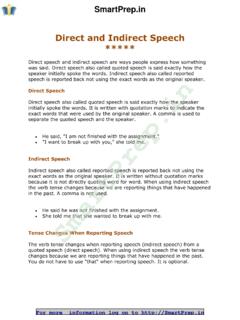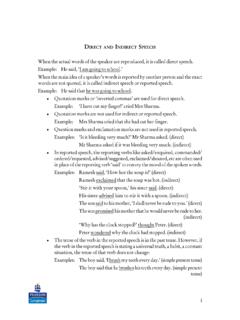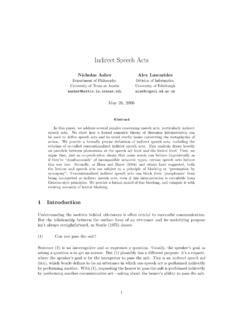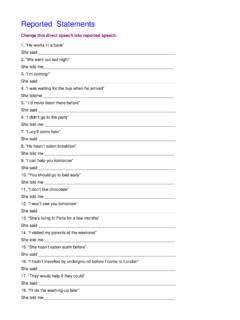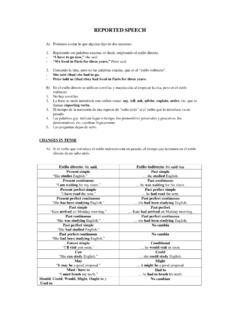Transcription of Responding to Indirect Speech Acts - Stanford University
1 COGNITIVE PSYCHOLOGY 11, 430-477 (1979) Responding to Indirect Speech acts HERBERT H. CLARK Stanford University Indirect Speech acts , like the request Do you know the time?, have both a literal meaning, here I ask you whether you know the time, and an Indirect meaning I request you to tell me the time. In this paper I outline a model of how listeners understand such Speech acts and plan responses to them. The main proposals are these. The literal meaning of Indirect Speech acts can be intended to be taken seriously (along with the Indirect meaning) or merely pro forma. In the first case listeners are expected to respond to both meanings, as in Yes, I do-it s six, but in the second case only to the Indirect meaning, as in It s six. There are at least six sources of information listeners use in judging whether the literal meaning was intended seriously or pro forma, as well as whether there was intended to be any Indirect meaning.
2 These proposals were supported in five experiments in which ordinary requests for information were made by telephone of 950 local merchants. Most sentences can be used to convey meanings indirectly. IS Julia at home? can be used in its literal sense to ask a question, a direct Speech act. On the telephone it can also be used as a request to call Julia to the phone, an Indirect Speech act. Although much is known about the linguis- tic properties of Indirect Speech acts (see, , Cole & Morgan, 1973, less is known about the processes by which they are produced or under- stood. In understanding, there are two questions of particular interest. How do listeners decide whether an utterance should be taken directly or indirectly? And if it is to be taken indirectly, how do they decide what its Indirect meaning should be? To get at these questions, I have chosen to study not just Indirect Speech acts , but also people s responses to them. Take Is Julia at home?)
3 When it is construed literally, it elicits such responses as Yes, she is or No, she isn t. But when it is construed as an Indirect request, it elicits two distinct classes of responses. In some contexts it leads to simple re- sponses, like I ll get her or Just a minute, which respond to the Indirect meaning alone. In other contexts it leads to two-part responses, like Yes, This research was supported in part by Grant MH-20021 from the National Institute of Mental Health, by the Center for Advanced Study in the Behavioral Sciences, and a Na- tional Endowment for the Humanities Fellowship. I thank Eve V. Clark, Philip N. Johnson-Laird, Willem J. M. Levelt, Ellen M. Markman, Jerry L. Morgan, Ivan A. Sag, Edward E. Smith, and Ewart A. C. Thomas for their counsel on various aspects of the research and the manuscript. I am most deeply indebted to Susan L. Lyte, who sacrificed her left ear and right index finger to make this research possible.
4 Reprint requests should be sent to Herbert H. Clark, Department of Psychology, Stanford University , Stanford , CA 94305. 430 OOlO-0285/79/040430-48$0500/O Copyright @ 1979 by Academic Press. Inc. Indirect Speech acts 431 she is-I ll get her, the first part of which, Yes, she is, answers the literal question, and the second part, 1 11 get her, responds to the Indirect re- quest. When do the one- and two-part responses occur, and why? These are two questions I will be particularly interested in. I will argue that they bear critically on how Indirect Speech acts should be characterized and how they are actually understood. Responses to Indirect Speech acts , however, are important in their own right. In ordinary conversation, many Speech acts , whether direct or indi- rect, come in what have been called adjacency pairs. Requests are re- sponded to by promises of compliance, questions by answers, offers by acceptances or refusals, and assertions by acknowledgments.
5 The first half of each adjacency pair is intended to set up its response, and the second half, to satisfy the obligations set up. In conversation, it is these adjacency pairs that enable the participants to coordinate turn taking, the introduction and changing of topics, and the opening and closing of the conversation itself (Goffman, 1976; Sacks, Schegloff, & Jefferson, 1974; Schegloff, 1968; Schegloff, Jefferson, & Sacks, 1977; Schegloff & Sacks, 1973). It is important to learn more about adjacency pairs per se. This paper, then, is about how people respond to Indirect Speech acts . It is divided into four parts. In the first, after a review of the major properties of Indirect Speech acts , I propose a matching set of properties for their responses. In the second part, I outline a model of how people understand Indirect Speech acts and plan their responses. In the third part, I report five experiments that were designed to refine this model.
6 And in the final discussion, I pull all these refinements together. Indirect Speech acts AND THEIR RESPONSES My first goal is to lay out six major properties of Indirect Speech acts drawn from the philosophical and linguistic literature on the subject, pro- pose a similar set of properties for their responses, and show how the two sets match. I will speak of A, a generic woman who performs the Indirect Speech acts , and B, a generic man who responds to her. They can be thought of as Ann and Bob. Six Properties of Indirect Speech acts (I) Multiplicity of meanings. direct Speech acts are intended to have just one meaning, or illocutionary force. In uttering It s ruining out as a direct Speech act, A means simply I assert to you that it is raining out. Indirect Speech acts , according to Searle (1975), always have more than one meaning, or illocutionary force. In uttering This soup needs salt in the right circumstances, A may mean both I assert to you that this soup needs salt and I request you to pass the salt.
7 Let us call these mean- ings M, and M,. M,, which follows directly from the literal meaning of the 432 HERBERT H. CLARK sentence, is generally called the speaker s literal or direct meaning. M2 is generally called the Indirect or conveyed meaning. M1 and M, are not meanings of the sentence This soup needs salt. Rather, they are the two parts of what A means in uttering the sentence on this occasion. In Grice s (1957, 1968) and Schiffer s (1972) terminology, they are speaker mean- ings. (2) Logical priority of meanings. The several meanings of an Indirect Speech act are not conveyed in parallel. In uttering This soup needs salt, A requests B to pass the salt 6y virtue ofher assertion to him that the soup needs salt (Searle, 1975). So M, and M2 form a chain of meanings in which M, is logically prior to M,, or M2 is logically contingent on M,. We can refer to M, and Mz as the initial and final meanings of such a chain. Just because M1 is logically prior to Me, of course, doesn t necessarily imply that M1 is temporally prior to M2 in any psychological sense.
8 These are two separate issues. Most Indirect Speech acts have chains with just two meanings, but longer chains are common too. By uttering Haven t youforgotten to clean your room?, for example, A can use her literal question, M1, to assert that B has forgotten to clean his room, M,; she can use Mz to convey another assertion, MS, that she wants B to clean his room now; and she can use M, to request B to clean his room now, M4. In an independent chain, she can also use M2 to scold B for not having cleaned his room before, M5. So there can be more than two meanings in a chain and even more than one chain. (3) Rationality. The logical contingency between any two meanings of an Indirect Speech act, according to Gordon and Lakoff (1971), Heringer (Note I), Searle (1975), and others, has a rational basis. For A to utter This soup needs salt and intend both M, and M,, she must first assume that she and B mutually know certain background facts (see Lewis, 1969; Schiffer, 1972; Clark & Clark, 1979; Clark & Marshall, 1978, 1980).
9 They may have to share the knowledge, for example, that they are at dinner, that she has just tasted the soup, that there is a salt-shaker near him, and other such facts. She must also observe certain principles of cooperative conversation (Grice, 1975). For one thing, her utterance must be relevant to what is going on at the moment. Finally, she must adhere to certain conventions about the use of sentences in performing direct Speech acts . Only then can she be certain that B will be able to infer that she intended both M1 and M2. (4) Conventionality. As part of this rationale, there are conventions M, and Mz are called the secondary and primary illocutionary acts , respectively, by Searle (1975, p. 62). I have avoiddd these terms, which are difkult to extend to chains with more than two meanings (see later). Indirect Speech acts 433 about which sentences can be used for which Indirect Speech acts . One convention of English is that A can indirectly request B to do a particular act by questioning his ability to do that act.
10 A can request the salt, there- fore, with Can you reach the salt?, Are you able yet to pass the salt?, and Is it possible for you to pass me the salt? This type of convention could be called a convention of means, since it specifies a semantic device by which an Indirect Speech act can be performed. There are also conventions ofform-conventions about the wording of Indirect Speech acts . Can you pass the salt? and Could you pass the salt?, for example, are highly conventional, or idiomatic, forms in English for requesting the salt. Is it possible for you to pass the salt? and Are you able to pass the salt? are less idiomatic, and Is it the case that you at present have the ability to pass the salt?is not at all idiomatic. So idiomaticity, an alternative term for conventionality of form, is a matter of degree. One piece of evidence for this continuum is that please can be inserted at many points in the highly idiomatic Indirect requests but at fewer or no points in the less idiomatic ones (Sadock, 1972, 1974).













